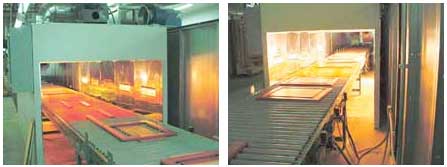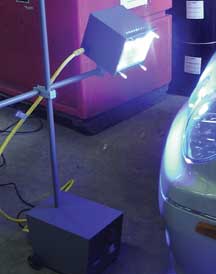What's Hot in Curing

Thermal reaction of a coating provides superior performance and predictable drying times. Convection heating has long been the benchmark for curing most coatings, providing a fairly wide process window and predictable results across a broad range of operating conditions (time, temperature, mass, etc.) While convection ovens are still widely used and have broad acceptance in the marketplace, there are some new ideas and some old ideas being used with greater frequency.
In addition to convection, infrared (IR), near-infrared (NIR) and ultraviolet (UV) light energy have been used for curing for some time now. Interest in different cure methods and how to use them has been on the rise as new coatings are developed, new applications are adopted, and cost and space issues are considered.
"They're all valid curing methods," says Dale Holroyd, senior vice president of sales and marketing for Catalytic Industrial Systems (Independence, KS). "They all have their place. It boils down to the application and the end-user's requirements. Floor space and budgets are issues for a lot of companies," he says. "Or maybe they're looking for quicker cure times and increased production."
"It's all about newer, better, faster," says Nick Fusilli of Thermal Innovations (Mannasquan, NJ). For example, some liquid coatings may dry differently under different environmental conditions. This can be a real challenge in hot and humid conditions. And in a just-in-time environment, companies need quick color change. "How do you deal with that in an oven for powder coating?"

Conversion from Liquid to Powder
Holroyd says he's seeing many companies switch from liquid coatings to powder. That's because it's often hard to beat powder coatings for their combination of environmental friendliness and finish quality. But existing convection oven equipment that is currently used for a liquid coating may not have enough time or energy to provide the necessary cure cycle for powder coatings.
"People will switch to powder, which requires higher temperatures to cure, and find that their existing oven does not allow enough residence time at temperature for the coating to cure," Holroyd says. As a result, many coaters have adopted the use of infrared systems designed to give a jump-start to curing before the parts go into the convection oven. "An infrared ramp system, for example, on the front end does a lot of great things. It imparts temperature real fast, which allows the existing oven to soak out the temperature and cure the coating."
Infrared in the short wavelength is often electric tungsten filament (quartz lamps), which provides high radiant efficiency and deep penetration with very fast response times. Similar systems are designed in the medium wavelength and may have better absorption characteristics with certain polymers. Long-wavelength emitters are often nickel chrome filament (quartz lamps or metal rods), which has a lower radiant efficiency but may be more rugged and better suited to coatings that require less surface temperature.
Infrared technology that has been around for a long time now is growing in acceptance, according to Mike Grande, technical vice president of Wisconsin Oven Corp. (East Troy, WI), which offers convection and IR ovens. There are many variations of IR in intensity and type of emitter, including gas and electric systems. Grande has seen some increase in the acceptance of gas catalytic, which he feels is due to a couple of factors. First, he says, the higher temperatures can mean shorter ovens, which conserve floor space. Second, people are starting to realize the process can do more than one might initially think.
"For example, they can cure heavy loads with thick cross-sections in a shorter time," Grande says. "Another good example is a complex shape, where line-of-sight issues are normally a problem with other types of IR," Grande says. "Gas catalytic is more forgiving under those circumstances. There is some convection because the heaters have a blower that stirs the air and helps the heat reach hidden areas."
These gas-fired catalytic systems are useful for liquid systems where low-density parts require temperatures that are not too intense. "Fast response times, high energy levels and clean burning are also important considerations, says Fusilli. "An emitter with low thermal mass and high output can provide much better efficiency for applications with higher temperature requirements, such as powder coatings."
For example, a direct-fired emitter with a ceramic fiber-face refractory board will put out just what is needed when it is needed, much like modulating a gas burner on a convection oven. It is efficient, clean burning and needs very little maintenance."
While IR is often helpful with liquid coatings, Fusilli thinks that no powder oven should be installed without some IR. "In Europe, about 90% of the powder ovens have some IR."
With space and time becoming more and more important to coaters, it seems only logical to include IR as part of the cure process. "With powder, the IR can sinter the powder film before it hits the moving air in the convection zone," Fusilli says. "This speeds up the curing process, limits dirt in the convection area and allows the airflow in the convection oven to be aggressive without disturbing the uncured powder."
While the convection oven has historically offered a broad process window and was very user-friendly, the trend in curing today is more focused on faster times and more-powerful cure technologies. "Companies want faster cure and higher production rates but the flip side of that is more sophisticated control, a more temperamental process and more-expensive equipment," says Paul Mills, of UVPowerhouse (Strongsville, OH). "These types of ovens are very powerful but also very focused."
Using an IR oven for curing a waterborne coating can provide significant advantages, according to Fusilli. "At one installation, we were able to use IR on a catalyzed material and make a huge difference in cure time. The customer used to wait overnight for the waterborne coating to dry. Now the prime coat is cured in 9 minutes and the top coat is cured in 18 minutes."
A Little Boost
An area of increased interest for IR is the booster oven used at the entrance of the convection oven. "Companies often want to speed up an existing line and switch from solventborne to waterborne coatings," says Holroyd. "We run into that all the time. Sometimes waterborne coatings take a little longer, so they need to slow the line down, which might cause a bottleneck in production. If they put an IR booster on the front, they can switch coatings and not have to slow the line. A one-minute boost will do a lot to get the temperature up."
"It is very rare that IR alone is suitable for full cure of an organic coating," says Fusilli. "Unless the product has uniformity, the use of convection for a portion of the cure is still useful to the overall process."
"For typical sheet-metal products we find that 20 to 30 seconds of IR provides more than enough energy to substantially reduce the energy needed in the convection portion of the oven," Fusilli says. And in another example, a manufacturer of very large products uses three minutes of gas-fired IR to avoid extremely long bring-up time that would be required for convection alone. "Their bring-up time would have been in excess of two hours, a ridiculously long time to wait for cure in a production environment. The IR boost cuts the cure time to less than half what it would have been with convection alone."
Fostoria Industries (Fostoria, OH), a manufacturer of gas and electric infrared ovens, is also paying close attention to the trend toward using IR systems in a booster-type configuration. They lend themselves to almost any system, says Steve Fruth, sales and marketing vice president for the manufacturer.
"Obviously infrared needs line-of-sight contact with the material," Fruth says. "So there are some geometric configurations that don't lend themselves to IR." Likewise, parts that are different sizes, weights, shapes and thickness may require a convection oven. "But boosters can get a lot of things up to temperature quickly. Boosters are big, and UV is gaining more prominence," Fruth says.

Ultraviolet Curing
"We haven't gotten into UV, but there's definitely a case to be made for it," Fruth says. "When the formulators get it right, UV is an excellent way to go, especially on the high-speed lines."
UV-curable coatings are available in liquid formulas and powder coatings. As Fruth says, UV systems are gaining in prominence, but there are some in the industry who say that UV-curable powders might still have a way to go on the research and development side before they're completely up to snuff. One is Pete Sink, a sales spokesman for Pneu-Mech Systems Manufacturing Inc. (Statesville, NC), a provider of finishing systems equipment.

"At one time you'd think UV was going to take over the world," Sink says. "I don't know whether the UV-curable powders provide the same performance as convection or combination IR/convection coatings. I wonder whether the photoinitiators are causing the performance to drop off."
Actually, UV powders have shown a lot of promise, says Fusilli. "Low-temperature cure powders on heat-sensitive substrates have found some acceptance in the marketplace, but the performance of the coating is inferior to UV powders."
Mike Stuhldreher, market development manager for DuPont Powder Coatings (Houston), feels that the powder materials are ready. "We at DuPont anticipate that new curing technologies such as UV and NIR will allow for nontraditional powder substrates to now be coated with powder. This will increase the overall market for powder coatings, and bring the environmental and operational advantages of powder to new industries.
According to Mills, there are two primary factors that have limited the growth of the UV powder industry. "The slow economy came at a time when UV acceptance was just beginning to develop. But another factor that may be more important is the expense and sophistication of these systems."
He feels that the trend in UV is just the opposite of thermal-cure systems. "Thermal-cure technology has tended to move to a more powerful but narrower process window. Convection has moved to hybrid systems, some IR alone and now even to NIR. Each step provides faster and more intense curing but also requires more precision and control."
UV technology needs to move in the other direction to gain more broad-based acceptance and use, Mills says. "The future in UV lies in the development of more robust technology that is more flexible and has broader applications. This will sacrifice some speed and intensity, but it will also be more flexible, less temperamental, easier to maintain and less expensive."
He points to the development of lamps and coatings to be used for the refinishing of cars as an example. "UV has the potential to be so much more rapid and produce very high quality results. But it also must be safe and easy to use for the average job shop." He feels that this is what is needed to move UV out of limited traditional markets such as fiber optics and into a broader group of users.
As new technologies are developed or come to the fore, there are other challenges facing the industry. For example, matching a preparation/coating/curing process with a substrate-and achieving results deemed acceptable by the marketplace-is an ongoing process.
The MDF Challenge
One of the key areas of interest for several years has been the application of powder coatings on medium density fiberboard (MDF). But with a slowing economy, manufacturers have been reluctant to put out the capital investment required to put a marketable powder finish on MDF, slowing the growth of this market. Powders have been manufactured to cure with lower temperature thermal curing alone and with UV. While a few companies have gone into business using each of these curing methods, the growth in powder on MDF still lags behind early expectations.
While powder coating on MDF could be a "big thing" for the woodworking and furniture industries, Fruth says, Fostoria hasn't actively pursued it. On the other hand, Catalytic Industrial Systems has gotten more involved in powder coating MDF in the last couple of years and has had success with its catalytic infrared, Holroyd says.
"To achieve the proper results on MDF, you need to modify the design parameters from those commonly used to cure powder on more traditional substrates," Holroyd says. "Also, the introduction of lower-temperature-cure powders has contributed to the success of this technology."
Waterborne Coatings vs. Powder Coatings
Current trends on the liquid-coating side seem to center on a move from solventborne coatings to waterborne materials. The idea is to reduce the amount of VOCs released into the atmosphere. These compounds are of special concern because they photochemically react in sunlight to cause ozone or smog in the lower atmosphere and destroy protective ozone in the upper atmosphere.
"When the amount of VOCs produced is important, manufacturers are moving away from solvents and toward waterborne products," Fruth says. "But the biggest emphasis now is on powder curing. Far and away, the topic of most discussions is that powder is the way to go when at all possible. It's durable and environmentally friendly."
Switching to waterborne coatings may be an environmentally friendly thing to do, but some say the waterborne coatings are more difficult to use than solventborne alternatives. Evaporation of water from the film is slower and more sensitive than solvent evaporation, and flash-off time and temperature are more important.
Grande says that waterborne coatings take longer to cure than solventborne coatings, noting that it may be unwise to compensate by cranking up the thermostat. Again, this may point to an emerging role for preheating systems. "You can't use higher temperatures in the oven because the [waterborne coatings may] start to blister before they come out," he says. Manufacturers generally agree that increasing temperature above the recommended level can cause performance and appearance problems with the finished film.
Working with Halogen
IR systems with halogen lamps, which typically have a lower intensity than other types of lamps, are being used to cure both solventborne and waterborne coatings. "We've successfully been able to dry with halogen lamps in three minutes," Sink says. "The companies that are aggressive today are trying to help customers put a system in a smaller footprint and are working with them to get flash times shortened. Halogen is a good tool for a confined space."
Waterborne coatings that Sink has seen on nonwood substrates don't require any flash time when dried with halogen. "That's a tremendous asset in reducing the overall size of the system," he says. "Not having to worry about long flash times before you can subject substrates to heat provides a lot of opportunities."
"Of the catalyzed systems we work with, most have a flash time of about nine minutes," Sink says. "That can be shortened to maybe five minutes. Once it's properly flashed, halogen allows us to cure the coating in about three minutes" using a three-zone curing oven in which each zone can be set at a different temperature. Convection would take considerably longer, maybe 12-15 minutes, depending on the coating."
Summary
So the industry needs easier-to-use cure technology that is inexpensive and easy to maintain. At the same time, it needs to be faster, better and more cost effective to use. With the wide variety of devices available, the options are numerous. The key is to do the research and testing to develop the right system for a coating and a particular installation.
"The focus should be on the process," says Fusilli. "Curing is not a one-size-fits-all proposition." Testing of different approaches can lead to an understanding of how best to apply known technology to meet the demands of a given situation. It is particularly important to perform diligent testing when the technology is more intense. As you progress through the spectrum of technology from convection to infrared to near infrared and UV, the application of cure energy becomes more intense and requires more precise application to avoid problems.
Looking for a reprint of this article?
From high-res PDFs to custom plaques, order your copy today!





